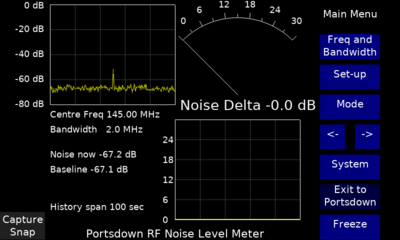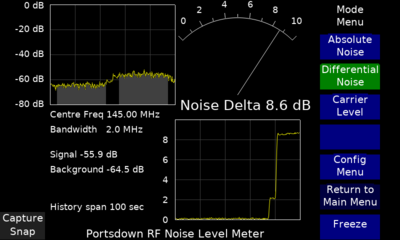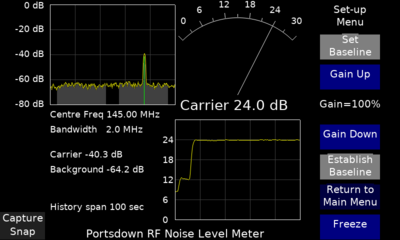Portsdown Noise Meter
The Portsdown Noise Level Meter uses a LimeSDR to measure and indicate noise or carrier power levels. It has 3 modes:
- Absolute Noise Measurement
- Differential Noise Measurement
- Carrier Level Measurement
Absolute noise measurement is used to measure Sun or Moon noise. The system can be "zeroed" against cold sky, and then the meter will indicate the increase in noise averaged over a wide bandwidth. Differential noise measurement can be used to measure the strength of DATV transmissions or possibly to optimise aerial/receiver matching. The noise power in a reference (quiet) frequency range is measured and compared with the noise power in a frequency range that contains a DATV signal. The Carrier Level measurement compares the peak level of a carrier within a defined frequency range with the average noise level in a quiet frequency range.
The Noise Level Meter is selected from Menu 2, Test Equipment. Web view (but not web control) is implemented for the Noise Level Meter.
Absolute Noise Measurement
On starting the meter, select the frequency and bandwidth required. Connect the receiver or preamp to the input of the LimeSDR and, on the setup menu, adjust the Lime Gain so that the noise level is around -60 dB. Noise background noise levels below this are outside the linear range of measurement. Press the "Establish Baseline" button and the meter should read near zero. Any increases in noise from the baseline level will then register on the meter. The spectrum plot allows interfering signals that may upset the reading to be seen. The "DC spike" in the centre of the spectrum is rejected from the calculations.
The meter scale can be changed through 6 ranges by touching the right and left sides of the meter face. The ranges are
- 0 to 30 dB (default)
- 20 to 30 dB
- 10 to 20 dB
- 0 to 10 dB
- 0 to 5 dB
- -5 to +5 dB
The meter reading is recorded on the history chart. The default length of the history is 100 seconds. This can be changed from the 2nd Config Menu (select Freq and Bandwidth, Config Menu, More Config). The smoothing time for the noise reading can also be adjusted here.
Differential Noise Measurement
The differential noise measurement mode is selected from the Mode Menu and compares the noise level in 2 frequency ranges.
The frequency ranges are indicated by the shaded areas and can be adjusted from the Config Menu. The adjustment figures are percentages of the span width.
Carrier Level Measurement
Carrier level mode is selected from the Mode Menu. Again, the average level of noise in one frequency range is used as the reference. However, the peak level of the strongest signal in the second frequency range is used for comparison.
The position of the peak is indicated by a green line. The time smoothing is automatically increased in this mode to obtain a stable reading suitable for use in the optimisation of systems.
A "Flat Top" windowing function is used to measure the peak amplitude, which provides an almost constant reading across 2 fft "bins". While this is good for stability, there is a 4 dB reduction in apparent sensitivity compared to the Hanning windowing function used in the absolute and differential modes.


